Peanuts
by
Charles M Schulz
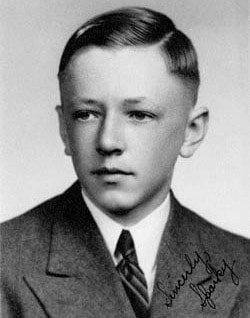 The
poetry of Schulz’s life began two days after he was born in Minneapolis,
Minnesota, on November 26, 1922, when an uncle nicknamed him “Sparky”
after the horse Spark Plug from the Barney
Google comic strip. Sparky’s
father, Carl, was of German heritage and his mother, Dena, came from a
large Norwegian family; the family made their home in St. Paul, where
Carl worked as a barber. Throughout his youth, father and son shared a
Sunday morning ritual reading the funnies; Sparky was fascinated with
strips like Skippy, Mickey Mouse, and Popeye.
In his deepest desires, he always knew he wanted to be a cartoonist, and
seeing the 1937 publication of his drawing of Spike, the family dog, in
the nationally-syndicated Ripley’s Believe it or Not newspaper
feature was a proud moment in the young teen’s life. He took his
artistic studies to a new level when, and with the encouragement of his
mother, he completed a correspondence cartoon course with the Federal
School of Applied Cartooning.
The
poetry of Schulz’s life began two days after he was born in Minneapolis,
Minnesota, on November 26, 1922, when an uncle nicknamed him “Sparky”
after the horse Spark Plug from the Barney
Google comic strip. Sparky’s
father, Carl, was of German heritage and his mother, Dena, came from a
large Norwegian family; the family made their home in St. Paul, where
Carl worked as a barber. Throughout his youth, father and son shared a
Sunday morning ritual reading the funnies; Sparky was fascinated with
strips like Skippy, Mickey Mouse, and Popeye.
In his deepest desires, he always knew he wanted to be a cartoonist, and
seeing the 1937 publication of his drawing of Spike, the family dog, in
the nationally-syndicated Ripley’s Believe it or Not newspaper
feature was a proud moment in the young teen’s life. He took his
artistic studies to a new level when, and with the encouragement of his
mother, he completed a correspondence cartoon course with the Federal
School of Applied Cartooning.
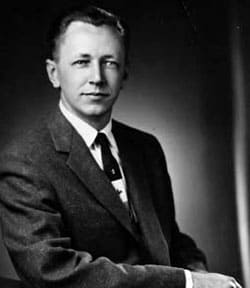 As
Schulz continued to study and hone his artistic style from the late
1920s through the 1940s, the genre of comic art experienced a great
shift. The full-page comics of the 1920s and 30s afforded artists the
space to reflect the Art Deco details and sensibilities of the day,
including the highly-stylized illustrations of Dick Tracy and
Little Nemo in Slumberland. Newspaper editors in the late
1940s and 50s, however, promoted a post-War minimalist model, pushing
their cartoonists to shrink strip size, minimize pen strokes, and
sharpen their humor with daily gags and cerebral humor for an
ever-increasingly educated audience. Schulz’s dry, intellectual, and
self-effacing humor was a natural fit for the evolving cultural
standards of the mid-20th century comics.
As
Schulz continued to study and hone his artistic style from the late
1920s through the 1940s, the genre of comic art experienced a great
shift. The full-page comics of the 1920s and 30s afforded artists the
space to reflect the Art Deco details and sensibilities of the day,
including the highly-stylized illustrations of Dick Tracy and
Little Nemo in Slumberland. Newspaper editors in the late
1940s and 50s, however, promoted a post-War minimalist model, pushing
their cartoonists to shrink strip size, minimize pen strokes, and
sharpen their humor with daily gags and cerebral humor for an
ever-increasingly educated audience. Schulz’s dry, intellectual, and
self-effacing humor was a natural fit for the evolving cultural
standards of the mid-20th century comics.
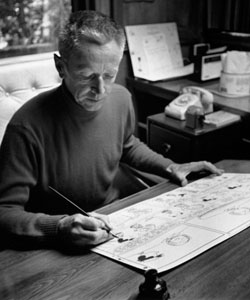 After
returning from the war in the fall of 1945, Schulz settled with his
father in an apartment over Carl’s
barbershop in St. Paul, determined to realize his passion of becoming a
professional cartoonist. He found employment at his alma mater, Art
Instruction, sold intermittent one-panel cartoons to The Saturday
Evening Post, and enjoyed a three-year run of his weekly panel
comic, Li’l Folks, in the local St. Paul Pioneer Press.
These early published cartoons focused on concise drawings of precocious
children with large heads who interacted with words and actions well
beyond their years. Schulz was honing his skills for the national
market. The first Peanuts strip appeared on October 2, 1950,
in seven newspapers nationwide. Although being a professional
cartoonist was Schulz’s life-long dream, at 27-years old, he never could
have foreseen the longevity and global impact of his seemingly-simple
four-panel creation.
After
returning from the war in the fall of 1945, Schulz settled with his
father in an apartment over Carl’s
barbershop in St. Paul, determined to realize his passion of becoming a
professional cartoonist. He found employment at his alma mater, Art
Instruction, sold intermittent one-panel cartoons to The Saturday
Evening Post, and enjoyed a three-year run of his weekly panel
comic, Li’l Folks, in the local St. Paul Pioneer Press.
These early published cartoons focused on concise drawings of precocious
children with large heads who interacted with words and actions well
beyond their years. Schulz was honing his skills for the national
market. The first Peanuts strip appeared on October 2, 1950,
in seven newspapers nationwide. Although being a professional
cartoonist was Schulz’s life-long dream, at 27-years old, he never could
have foreseen the longevity and global impact of his seemingly-simple
four-panel creation.
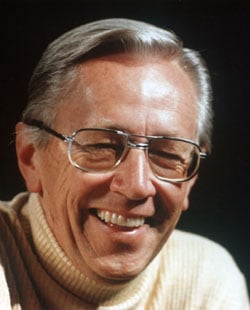 The
continuing popular appeal of Peanuts stems, in large part, from
Schulz’s ability to portray his observations and connect to his audience
in ways that many other strips cannot. As each character’s personality
has been fleshed out over the years, readers came to intimately
understand Linus’ attachment to his Security Blanket, Charlie Brown’s
heartache over the Little Red-Haired Girl, Schroeder’s devotion to
Beethoven, Peppermint Patty’s prowess in sports and failure in the
classroom, and Lucy’s knowledge of … well … everything. The rise in
Snoopy’s popularity in the 1960s had a direct correlation to his
evolution from a four-legged pet to a two-legged, highly-imaginative and
equal character in the strip, which allowed Schulz to take his
storylines in increasingly new directions.
The
continuing popular appeal of Peanuts stems, in large part, from
Schulz’s ability to portray his observations and connect to his audience
in ways that many other strips cannot. As each character’s personality
has been fleshed out over the years, readers came to intimately
understand Linus’ attachment to his Security Blanket, Charlie Brown’s
heartache over the Little Red-Haired Girl, Schroeder’s devotion to
Beethoven, Peppermint Patty’s prowess in sports and failure in the
classroom, and Lucy’s knowledge of … well … everything. The rise in
Snoopy’s popularity in the 1960s had a direct correlation to his
evolution from a four-legged pet to a two-legged, highly-imaginative and
equal character in the strip, which allowed Schulz to take his
storylines in increasingly new directions.
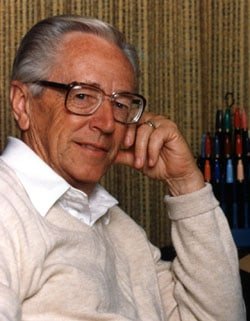 Schulz’s
understated genius lay in his ability to keep his well-known and
comfortable characters fresh enough to attract new readers while keeping
his current audience coming back for more. His humor was at times
observational, wry, sarcastic, nostalgic, bittersweet, silly, and
melancholy, with occasional flights of fancy and suspension of reality
thrown in from time to time. When Schulz announced his retirement in
December 1999, the Peanuts comic strip was syndicated in over
2,600 newspapers worldwide, with book collections translated in over 25
languages. He has been awarded with the highest honors from his fellow
cartoonists, received Emmy Awards for his animated specials, been
recognized and lauded by the U.S. and foreign governments, had NASA
spacecraft named after his characters, and inspired a concert
performance at Carnegie Hall. And still today, the Peanuts
Gang continues to entertain and inspire the young and the young at
heart.
Schulz’s
understated genius lay in his ability to keep his well-known and
comfortable characters fresh enough to attract new readers while keeping
his current audience coming back for more. His humor was at times
observational, wry, sarcastic, nostalgic, bittersweet, silly, and
melancholy, with occasional flights of fancy and suspension of reality
thrown in from time to time. When Schulz announced his retirement in
December 1999, the Peanuts comic strip was syndicated in over
2,600 newspapers worldwide, with book collections translated in over 25
languages. He has been awarded with the highest honors from his fellow
cartoonists, received Emmy Awards for his animated specials, been
recognized and lauded by the U.S. and foreign governments, had NASA
spacecraft named after his characters, and inspired a concert
performance at Carnegie Hall. And still today, the Peanuts
Gang continues to entertain and inspire the young and the young at
heart.